| THE ORIGIN OF CROSS-CUTTING ROCK BODIES Examine the following pictures. In each you will see bands or layers of one type of rock material running across distinctly different rock material. The questionS we want to address are: - How did these 'cross-cutting' bodies originate?
- How did they come to be 'cross-cutting'?
|
| OBSERVATIONS |
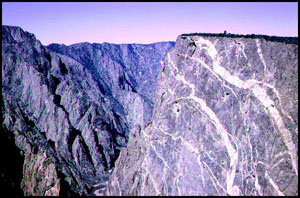
On the wall of this canyon, irregular but roughly parallel bands of light colored rock cut across a background of dark colored rock. The dark green band at the top of the cliff is a forest of trees tens of feet high. |
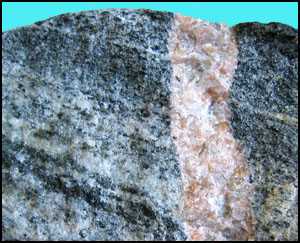
A one-inch wide band of pinkish-white rock with crystalline texture cuts across a rock with white and black layers. |
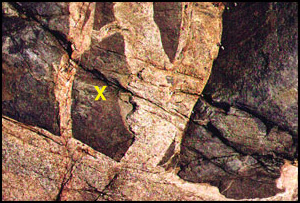
Multiple bands of light rock cut across dark rock. |
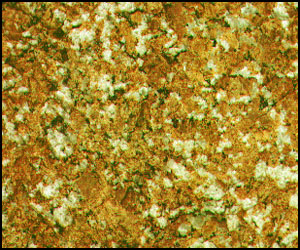
Here, the crystalline texture of the cross-cutting rock body shown in the picture to the left can be seen. |

A roughly 5-inch wide band of rock cuts perpendicularly across the layering of the surrounding rock. |
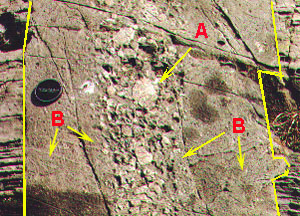
A detail of the picture to the left. The borders of the cross-cutting rock body are outlined in yellow. The cross-cutting rock has sand-size grains (B) except where, in its central region, larger rounded grains (A) are clustered. |

In this rock, white layers cut across dark rock. The white layers are made entirely of calcite. | |
HYPOTHESES:
HOW DO CROSS-CUTTING BODIES ORIGINATE? |
| The diagram below shows seven different hypotheses as to how cross-cutting bodies of rock originate and how they come to be cross-cutting. To simplify the diagram, there is no attempt at three-dimensionality. All cross-cutting bodies and the rocks they cut are shown as they would appear on the face of a vertical cliff. |
 |
|
| Of the seven scenarios of origin for cross-cutting rock bodies shown in the diagram, three involve igneous processes and four involve sedimentary processes. Six rock cross-cutting bodies formed after the rocks they cross-cut; one formed before. The following questions are designed to help you decide whether different scenarios of origin are distinguishable on the basis of evidence shown in the diagram. |
 Question 1: From the information provided above, can the shape of the cross-cutting body reveal its origin? Question 1: From the information provided above, can the shape of the cross-cutting body reveal its origin?
 Question 2: Can the mere presence of a zone of distinct character located at the interface between the cross-cutting body and the surrounding rocks serve to reveal its origin? Question 2: Can the mere presence of a zone of distinct character located at the interface between the cross-cutting body and the surrounding rocks serve to reveal its origin?
 Question 3: Can the texture of the cross-cutting body serve to reveal its origin? Question 3: Can the texture of the cross-cutting body serve to reveal its origin?
 Question 4: From your answers to questions 1 through 3, what conclusion can you reach as to whether it is possible to distinguish between the different scenarios of origin for cross-cutting bodies on the basis of the information supplied so far? Question 4: From your answers to questions 1 through 3, what conclusion can you reach as to whether it is possible to distinguish between the different scenarios of origin for cross-cutting bodies on the basis of the information supplied so far?
|
|
| It seems that in most cases, more information is needed to uniquely establish the origin of a cross-cutting rock body. Consider the field relationships shown below. |
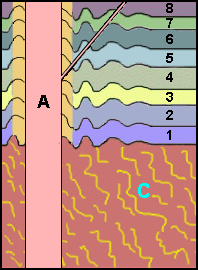 | Observations: The diagram on the left represents an exposed vertical cliff face. A series of eight parallel rock layers (1 through 8) extend across the top half of the diagram from left to right. They rest on an underlying unlayered rock body (C) shown as orange-brown with sqiggly yellow lines. Layers 1-8 are horizontal on the right half of the cliff face, but are folded in the vicinity of a pink, vertical cross-cutting rock body (A). In the vicinity of the boundaries of 'A', rock layers 1-8 are still distinguishable, but the characteristics they normally display have clearly altered. The altered zones are colored tan. A thin extension of vertical pink body 'A' cuts across layers 4-8. No tan zone separates layers 4-8 from the extension of 'A'. Rock body 'C' meets cross-cutting body 'A' directly. The tan zones are absent. |
| The next two diagrams provide a closer look at the structures, textures and mineralogy of the rock bodies decribed. |
 | Observations:-
The central part of rock body 'A' has a coarse grained, crystalline texture. Marginal parts of 'A', near its boundary with the altered zone and layered rocks, have a medium grained, crystalline texture.
Minerals present in both parts include potassium-rich feldspar, sodium-rich feldspar, quartz, mica.
- The unaltered part of rock layer 3 displays ripple marks.
- The unaltered part of rock layer 1 displays shell fossils.
- Rock body 'C' has a crystalline texture with oriented amphibole (green) and mica (brown) grains. Well-formed garnet crystals
(purple) are also present.
The next diagram takes a closer look at rock layers 1, 2 and 3.
|
|
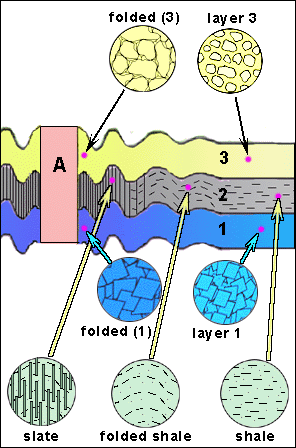 | In this diagram, the tan color that represents 'altered zones' adjacent to rock body 'A', has been omitted. Instead, the nature of the alteration is shown in the texture circles and described in the narrative. Observations:
- Layer 1: to the right, a fine-grained, crystalline rock made of calcite. Going left, the layer becomes folded and the grain size increases as 'A' is approached.
- Layer 2: to the right, a shale. Towards the center, the shale is folded. Continuing left towards 'A', the folded shale develops slaty cleavage and becomes slate.
- Layer 3: to the right, a clastic rock made of medium size quartz grains and a quartz cement. Going left, the layer becomes folded and the clastic texture alters to coarsely crystalline.
|
 Question 1: From the information provided above, does the hypothesis 'Layers 1 through 3 formed in a sedimentary environment' seem supported? Explain. Question 1: From the information provided above, does the hypothesis 'Layers 1 through 3 formed in a sedimentary environment' seem supported? Explain.
 Question 2: Does the hypothesis 'The changes observed in layers 1 through 3 as rock body 'A' is approached were imposed by rock body 'A'' seem supported? Explain. Question 2: Does the hypothesis 'The changes observed in layers 1 through 3 as rock body 'A' is approached were imposed by rock body 'A'' seem supported? Explain.
 Question 3: Does the hypothesis 'The rocks occupying the 'alteration zone' are metamorphic rocks' seem supported? Question 3: Does the hypothesis 'The rocks occupying the 'alteration zone' are metamorphic rocks' seem supported?
 Question 4: Which of the seven scenarios (hypotheses) described above for the formation of a cross-cutting body is most supported for the origin of rock body 'A'? Explain. Question 4: Which of the seven scenarios (hypotheses) described above for the formation of a cross-cutting body is most supported for the origin of rock body 'A'? Explain.
 Question 5: How might the absence of an altered zone (visible at the scale of this diagram) along the boundary between the extension of rock body 'A' and rock layers 4 through 8 be explained? Question 5: How might the absence of an altered zone (visible at the scale of this diagram) along the boundary between the extension of rock body 'A' and rock layers 4 through 8 be explained?
 Question 6: Nothing has been said about the origin of rock body 'C' nor about the absence of an altered zone along the boundary between rock body 'A' and rock body 'C'. What comments or questions do you have about these matters? Question 6: Nothing has been said about the origin of rock body 'C' nor about the absence of an altered zone along the boundary between rock body 'A' and rock body 'C'. What comments or questions do you have about these matters?
|
|
To check your answers and get additional hints and information, click on the link. |











 Question 1: From the information provided above, can the shape of the cross-cutting body reveal its origin?
Question 1: From the information provided above, can the shape of the cross-cutting body reveal its origin?